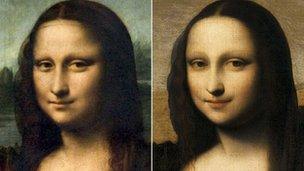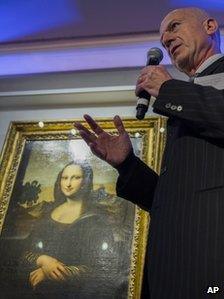'Early Mona Lisa' painting claim disputed
- Published

Side by side comparison of the two portraits, with the disputed painting on the right
A foundation in Switzerland believes it has scientific evidence to prove that Leonardo Da Vinci painted an earlier version of the Mona Lisa.
The Zurich-based Mona Lisa Foundation claims the painting, discovered in 1913, portrays a younger version of Leonardo's masterpiece in the Louvre.
The foundation is basing its claim on 35 years of research.
But Oxford professor Martin Kemp insists there is "no basis for thinking that there was an earlier portrait".
The painting, which has been held in a bank vault for more than 40 years, was unveiled to the press in Geneva on Thursday.
Known as the Isleworth Mona Lisa, the painting shows a woman who appears to be approximately 10 years younger than the Louvre Mona Lisa.
The foundation say forensic testing backs early suggestions that it is the same woman - Lisa del Giocondo, the wife of wealthy Florentine merchant.
Ever since the 16th century, sources have suggested that Da Vinci painted two versions of the Mona Lisa: a portrait for her husband, in 1503 (the Isleworth Mona Lisa), and another, completed in 1517, for Giuliano de Medici, Leonardo's patron - the portrait which now hangs in the Louvre.
The foundation says that historical evidence, critical comparison and scientific examination all support this theory.

The painting, known as the Isleworth Mona Lisa, was rediscovered in 1913
"Not one piece of scientific evidence has so far been able to prove definitively that this is not a Leonardo Da Vinci," said foundation member and art historian Stanley Feldman, on Thursday.
"We have investigated this painting from every relevant angle and the accumulated information all points to it being an earlier version of La Giaconda [Mona Lisa] in the Louvre."
However, the foundation acknowledged that the Isleworth Mona Lisa remains unfinished, and that Leonardo did not paint all parts of the work.
The unveiling of the Isleworth Mona Lisa was accompanied by the launch of a book called Mona Lisa - Leonardo's earlier version.
The painting was first discovered in the Somerset home of an aristocrat, in 1913, by art collector Hugh Blaker - who took it to his studio in Isleworth in south-west London.
Shipped to the US during World War I, it was bought in 1960s by American art connoisseur Henry Pulitzer.
While in his possession, and held in a Swiss bank, Pulitzer wrote and published a book, entitled Where is the Mona Lisa?, in which he presented the case that the painting was an unfinished portrait of Lisa del Giocondo by Leonardo Da Vinci.
The painting is currently owned by an anonymous consortium, making it unclear who would now benefit from it being attributed to the artist.
Alessandro Vezzosi, director of Museo Ideale Leonardo da Vinci, said the foundation's claims merit "consideration".
"The Isleworth Mona Lisa is an important work of art deserving respect and strong consideration," he said.
"Scientific tests don't demonstrate the authenticity (and) the autography of a painting, but demonstrate it's from a certain era, whether the techniques are similar or not," he told The Associated Press.
But Professor Kemp, who was instrumental in identifying a major work by Leonardo Da Vinci in 2010, is convinced it is a copy - though he has not personally viewed the painting.
"The Isleworth Mona Lisa mistranslates subtle details of the original, including the sitter's veil, her hair, the translucent layer of her dress, the structure of the hands," he said.
"The landscape is devoid of atmospheric subtlety. The head, like all other copies, does not capture the profound elusiveness of the original."
Professor Kemp also points out that the Isleworth version is painted on canvas, where Da Vinci's preferred choice was wood.
"The scientific analysis can, at most, state that there is nothing to say that this cannot be by Leonardo," said Mr Kemp. "The infrared reflectography and X-ray points very strongly to its not being by Leonardo."
Stanley Feldman has acknowledged the controversy surrounding the painting, saying: "There is always going to be somebody, somewhere who will dismiss it as a copy.
"We welcome every new discussion and every new piece of evidence that could support this painting, one way or another."
- Published27 September 2012
- Published29 September 2011